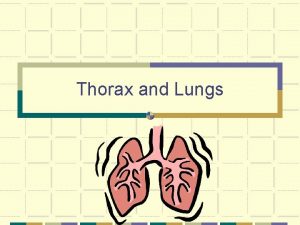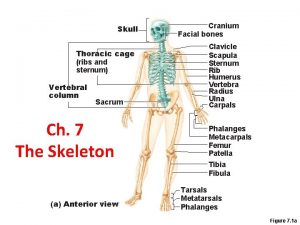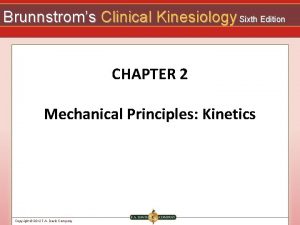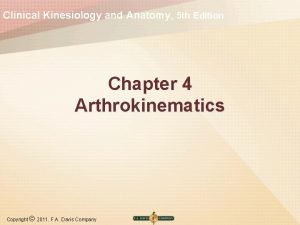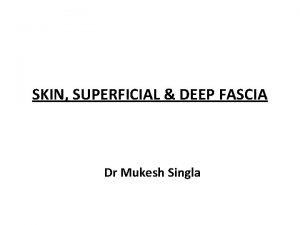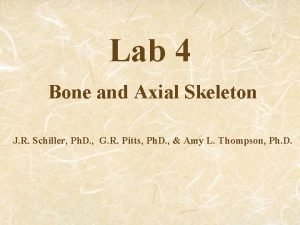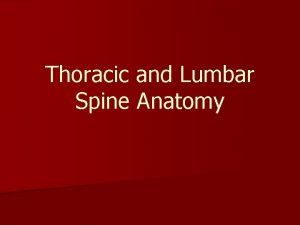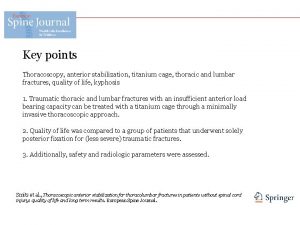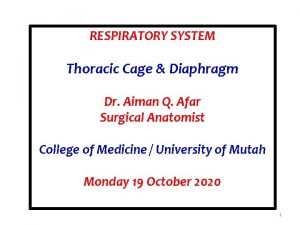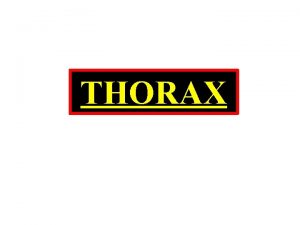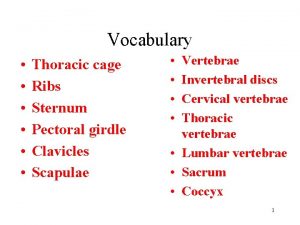Clinical anatomy of thoracic cage and cavity1 Dr



















- Slides: 19

Clinical anatomy of thoracic cage and cavity-1 Dr. Rehan

At the end of this session, the student should be able to: � Discuss briefly anatomical changes in thorax with ageing. � Describe needle and tube thoracostomy. � Identify indication of thoracotomy and structures encountered in performing it. � Briefly describe the anatomy for intercostal nerve block. Mention its possible complications. � Identify clinical application of diaphragm and pleural reflections. � Classify the congenital anomalies encountered in the ribs and diaphragm.

Anatomical changes with age � Rib cage becomes more rigid and inelastic. � Due to calcification and ossification. � Kyphosis: also termed as stooped appearance. � Increase in the sagittal contour of thoracic spine. � Normal curve is about 20 to 40 degree. � Occurs due to degeneration of intervertebral disc.

Anatomical changes with age �Disuse atrophy of thoracic and abdominal muscles. �Leads to poor respiratory movements. �Degeneration of elastic tissue in lungs and bronchi leads to altered movement in expiration.

Needle thoracostomy �Indications: �Tension pneumothorax �Drain fluid/pus from pleural cavity. �To collect sample from pleural fluid. �Two approaches of thoracostomy ü Anterior ü Lateral

Needle thoracostomy �Anterior approach: patient lie in supine position �Identify sternal angle �Identify 2 nd rib and insert needle in 2 nd intercostal space in mid clavicular line. �Lateral approach �Mid axillary line is used.

Needle thoracostomy �Skin, superficial fascia, serratus anterior muscle, external intercostal, innermost intercostal, endothoracic fascia and parietal pleura. �The needle should always pass through upper border of 3 rd rib to avoid damage to intercostal nerve and vessels in sub costal

Tube thoracostomy �Preferred site is fourth and fifth intercostal space. �Anterior axillary line. �Incision should be given at superior border of rib to avoid neurovascular damage.

Surgical access to chest � Thoracotomy ü Indication: penetrating chest injuries with intrathoracic hemorrhage. ü Incision in 4 th intercostal space from lateral margin of sternum to anterior axillary line. ü Line of the incision in intercostal space should be close to the upper border of rib. ü Right or left side depends

Surgical access to chest ü Structures to be avoided for damage in thoracotomy: q Internal thoracic artery q Intercostal vessels and nerves �Medial sternotomy ü Used to access heart, coronary arteries and valves.

Intercostal nerve block � 7 th to 11 th intercostal nerve supply skin and parietal peritoneum covering outer and inner surface of abdominal wall � Indications ü Repair of injuries of thoracic and abdominal wall. ü Relief of pain in rib fractures � Complications � Pneumothorax occurs if needle penetrates parietal pleura � Hemorrhage caused by

Intercostal nerve block � Procedure: to produce analgesia of anterior and lateral thoracic wall and abdominal wall � Perform rib counting from 2 to 12. � Select the superior part intercostal space. � Needle should direct towards the lower border of rib � The tip should come close to subcostal groove to infiltrate anesthetic agent around nerve. � To produce analgesia,

Diaphragm � Paralysis of single dome of diaphragm by sectioning of phrenic nerve. � Performed sometimes in treatment of chronic tuberculosis. � this will give rest to the lower lobe of the lung. � Penetrating injuries: ü Stab or bullet wound ü In any penetrating injury below the level of nipples, diaphragmatic injury is suspected

Pleural reflection � Cervical dome of pleura and apex of lungs most commonly damaged during: ü Stab wound in root of neck. ü By anesthetist needle during nerve block of lower trunk of brachial plexus. � Lower reflection of pleura may damage during nephrectomy.

Congenital anomalies of ribs �Cervical rib: �Arises from the anterior tubercle of transverse process of 7 th cervical vertebrae �Cause compression of subclavian artery �Compression of subclavian vein �Compression of T 1 nerve as it passes above first rib.

Cervical rib � On Plain AP radiograph demonstrate small horn like structure

Congenital anomaly of diaphragm � Congenital hernia � Due to incomplete fusion of septum tranversum, dorsal mesentery and pleuroperitoneal membrane. � Three common sites ü Pleuroperitoneal canal ü Opening between xiphoid and costal origin of diaphragm ü Esophageal hiatus

Summary �Anatomical changes with age �Thoracostomy and its sub types �Surgical access to chest �Intercostal nerve block �Cervical rib �Congenital anomaly of diaphragm.

References �Snell RS. Clinical Anatomy by Regions. 9 th edition, Lippincott Williams & Wilkins. �http: //emedicine. medscape. com/article/1264959 overview#a 0101 �http: //www. youtube. com/watch? v=4 cuot. NQPRNc
 How to measure ap diameter of chest
How to measure ap diameter of chest Parts of temporal bone
Parts of temporal bone Inferior articular process
Inferior articular process Thoracic cage anterior view
Thoracic cage anterior view Intercostal nerve
Intercostal nerve Superior intercostal veins
Superior intercostal veins Lung markings surface anatomy
Lung markings surface anatomy Brunnstrom's clinical kinesiology 7th edition
Brunnstrom's clinical kinesiology 7th edition Clinical kinesiology and anatomy 6th edition
Clinical kinesiology and anatomy 6th edition Phalanx
Phalanx Sensory cranial nerves
Sensory cranial nerves Nasal meatus drainage
Nasal meatus drainage Fascia
Fascia She locked hansel in a cage
She locked hansel in a cage Body cavities
Body cavities Mental anatomical term
Mental anatomical term Dorsal cavity diagram
Dorsal cavity diagram Lumbar vertebrae characteristics
Lumbar vertebrae characteristics They cage the animals at night doggie
They cage the animals at night doggie Speed control of squirrel cage induction motor
Speed control of squirrel cage induction motor
